aquarium plant guide
Welcome to the comprehensive guide on aquarium plants! Discover the essential knowledge for creating thriving aquatic ecosystems. Learn about plant benefits, selection, and maintenance to enhance your aquarium experience.
Overview of Aquarium Plants
Aquarium plants are essential components of a thriving aquatic ecosystem, offering beauty, functionality, and balance to freshwater tanks. They range from carpeting species like dwarf hairgrass to towering background plants such as Amazon swords. These plants provide shelter, food, and breeding grounds for fish while enhancing water quality by absorbing excess nutrients. Popular species include anacharis, java moss, and crypts, each with unique growth habits and requirements. Properly maintained, aquarium plants create a natural environment that mimics aquatic habitats, fostering healthier fish and a visually stunning display. Balancing plant selection with tank conditions ensures a harmonious setup, making them a vital part of any successful aquarium.
Benefits of Adding Plants to Your Aquarium
Adding plants to your aquarium offers numerous benefits, enhancing both aesthetics and functionality. Live plants improve water quality by absorbing excess nutrients like nitrates and phosphates, reducing algae growth. They produce oxygen, creating a healthier environment for fish. Plants also provide natural shelter and breeding grounds for aquatic life, promoting a balanced ecosystem. Their vibrant colors and diverse textures add visual appeal, transforming your tank into a stunning display. Additionally, plants help stabilize water parameters and reduce CO2 levels, benefiting both fish and plants. By integrating plants, you create a thriving, natural environment that mimics aquatic habitats, fostering a harmonious and sustainable aquarium ecosystem for years to come.

Choosing the Right Aquarium Plants
Selecting the ideal plants involves considering species popularity, lighting needs, available space, and maintenance requirements to ensure compatibility with your aquarium setup and skill level.
Popular Freshwater Aquarium Plant Species
Freshwater aquarium plants offer a wide variety of choices for aquarists. Popular species include Anacharis, known for its rapid growth, and Java Moss, a low-maintenance favorite. Amazon Swords and Cryptocorynes are beloved for their striking leaves, while Water Wisteria adapts well to different conditions. These plants not only enhance aesthetics but also improve water quality and provide habitats for fish. Anacharis and Hornwort are great for beginners, thriving in various lighting conditions. Java Moss and Anubias are ideal for attaching to driftwood or rocks, creating natural textures. These species are widely available and cater to different skill levels, making them perfect for building a vibrant, balanced ecosystem in your aquarium.
Factors to Consider When Selecting Aquarium Plants
When choosing aquarium plants, consider lighting requirements, water parameters, and tank size. Ensure plants match your aquarium’s light intensity, as some thrive in low-light conditions while others need intense illumination. Water hardness, pH, and flow rate are critical, as certain species are sensitive to these factors. Tank size and dimensions matter, as plants vary in growth habits and space needs. Maintenance requirements, such as trimming or nutrient uptake, should align with your care capacity. Additionally, think about the aquarium’s purpose—whether for aesthetics, water purification, or creating habitats for fish. Compatibility with fish and other aquatic life is also essential, as some plants may not coexist well with certain species. Balancing these factors ensures a harmonious and thriving ecosystem.
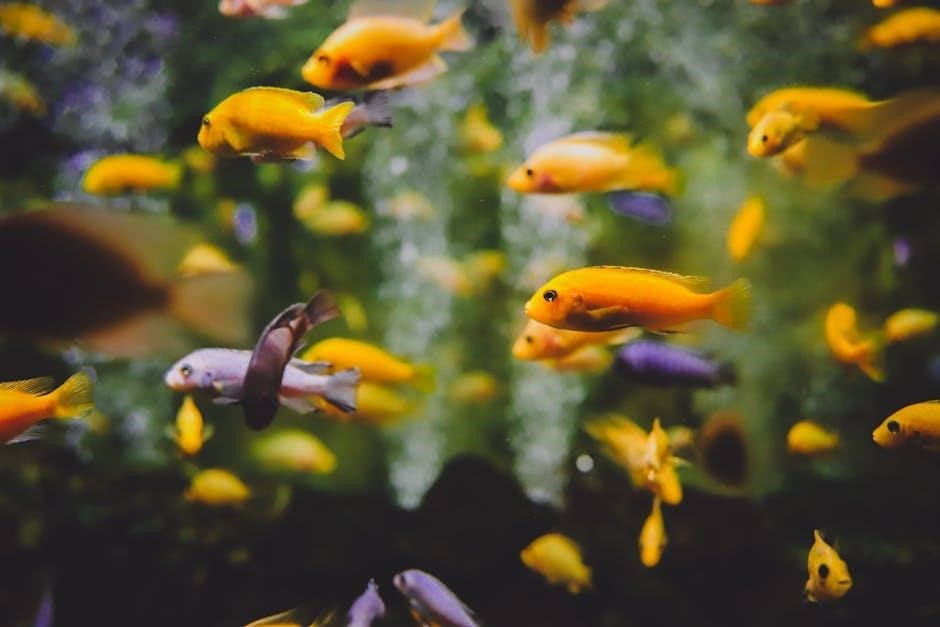
Planting Techniques for Aquarium Success
Master essential planting techniques, such as substrate preparation, proper plant placement, and handling methods, to ensure a thriving aquatic environment tailored to your aquarium’s needs.
How to Plant Different Types of Aquarium Plants
Planting aquarium plants requires careful techniques to ensure proper growth and stability. For root plants, bury the roots in the substrate while leaving the stem and leaves exposed. Stem plants can be planted directly into the gravel or soil, ensuring the node is submerged. Rhizome plants, like Anubias, should be tied to rocks or driftwood to prevent them from floating. Mosses and carpeting plants are best attached to stones or spread evenly across the substrate. Always handle plants gently to avoid damaging delicate tissues. Use aquarium-safe tools for planting, and avoid overcrowding to allow adequate light and nutrient distribution. Proper planting ensures a balanced and visually appealing aquarium ecosystem.
Maintenance Tips for Healthy Plant Growth
Regular water changes, proper trimming, and balanced nutrient levels are crucial for healthy plant growth. Monitor water parameters like pH, ammonia, and nitrate levels to ensure stability. Trimming overgrown plants prevents shading and promotes even growth. Use high-quality fertilizers tailored to your plants’ needs, avoiding over-fertilization. Maintain adequate water flow to distribute nutrients evenly. Replace old or depleted substrate periodically to replenish essential minerals. Avoid overstocking, as it stresses plants and disrupts water quality. Introduce beneficial bacteria to maintain a healthy ecosystem. Regularly clean filters and equipment to ensure optimal water circulation. Lastly, observe plant health daily and address any signs of decay or pests promptly to prevent setbacks.
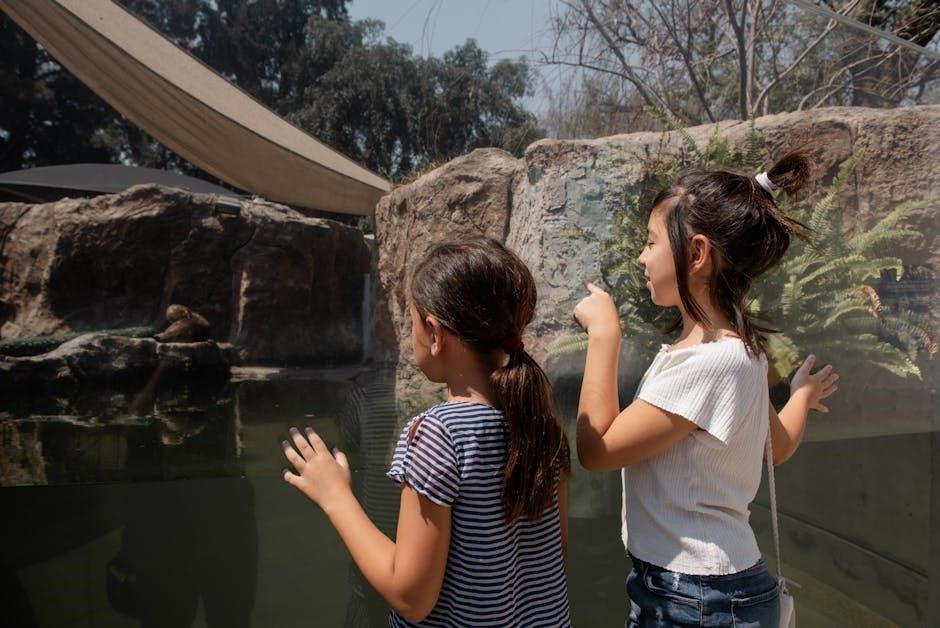
Lighting for Aquarium Plants
Lighting is crucial for aquarium plant growth, enabling photosynthesis. Ensure appropriate intensity and duration to support healthy development and vibrant colors in your aquatic plants.
Understanding Light Requirements for Aquarium Plants
Aquarium plants require specific lighting conditions to thrive. Most species need 10-12 hours of light daily, with intensities varying from low to high. Low-light plants, like Java Moss, tolerate minimal illumination, while high-light plants, such as stem plants, demand intense lighting. Natural light can supplement aquarium lighting but avoid direct sunlight to prevent overheating. LED and T5/T8 lights are popular choices, offering adjustable intensity and spectrum control. Proper photoperiods and light spectrum balance are crucial for healthy growth and vibrant coloration. Always research the specific lighting needs of your plants to ensure optimal conditions. Regularly monitor light levels and adjust as needed to promote thriving plant life in your aquarium.
Best Lighting Options for Promoting Plant Growth
LED lights are highly recommended for aquarium plants due to their energy efficiency and adjustable spectrum. They provide optimal light for photosynthesis without excessive heat. T5 and T8 fluorescent lights are also effective, offering consistent illumination. For low-tech setups, natural daylight can suffice, but avoid direct sunlight to prevent algae growth. The duration of lighting should mimic natural daylight cycles, typically 6-8 hours daily. Intensity depends on plant species; low-light plants like moss thrive under dimmer conditions, while carpeting plants require brighter light. Always research specific lighting needs for your aquarium plants to ensure healthy growth and vibrant colors.

CO2 and Nutrient Management
CO2 and nutrients are crucial for aquarium plant growth. Proper CO2 diffusion and balanced nutrient levels ensure healthy plants, while excess can harm your aquatic ecosystem.
Role of CO2 in Aquarium Plant Growth
CO2 plays a crucial role in aquarium plant growth by facilitating photosynthesis, the process by which plants convert light into energy. Plants absorb CO2 from the water, combining it with light and nutrients to produce oxygen and organic compounds essential for growth. In natural ecosystems, CO2 levels are maintained through biological processes, but in aquariums, these levels often drop due to plant absorption and gas exchange at the surface. Supplementing CO2, especially in high-light setups, enhances plant health, promotes vibrant colors, and prevents deficiencies. CO2 injection systems are commonly used in planted aquariums to maintain optimal levels, ensuring plants thrive without relying solely on ambient CO2. Proper balance is key to avoid harming fish and other aquatic life.
How to Manage Nutrients for Optimal Plant Health
Managing nutrients is crucial for the health and growth of aquarium plants. Ensure a balanced supply of macronutrients (Nitrogen, Phosphorus, Potassium) and micronutrients like Iron and Magnesium. Avoid over-fertilization, as it can harm plants and fish. Use high-quality fertilizers specifically designed for aquatic plants, and follow the manufacturer’s instructions. Regular water changes help maintain nutrient balance and prevent buildup. Monitor plant health and adjust nutrient levels accordingly. For low-tech setups, rely on fish waste and natural processes, while high-tech systems may require CO2 injection and precise nutrient dosing. Test kits can help track nutrient levels, ensuring optimal conditions for plant growth and aquarium stability.
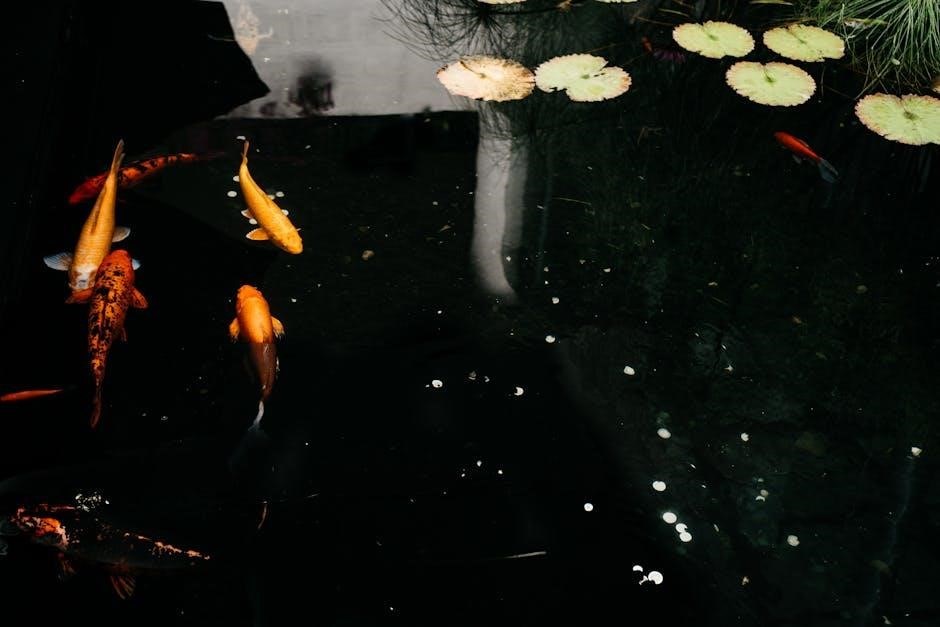
Combining Plants with Aquarium Hardware
Plants and aquarium hardware work synergistically, enhancing biological filtration and oxygen levels. Proper placement ensures equipment functionality while maintaining aesthetic balance and plant health naturally.
Using Filters and Heaters with Live Plants
When combining filters and heaters with live plants, it’s essential to strike a balance between equipment functionality and plant well-being. Choose filters that provide gentle water circulation to avoid damaging delicate plant leaves. Submersible filters or sponge filters are ideal for planted tanks as they create minimal current. Heaters should be positioned away from plants to prevent scorching and ensure even heat distribution. Regularly monitor water temperature, as most aquarium plants thrive in temperatures between 72°F and 82°F. Avoid placing plants directly over filter outlets or near heater intakes to maintain optimal conditions. This harmonious setup promotes healthy plant growth while keeping your aquarium ecosystem stable and thriving.
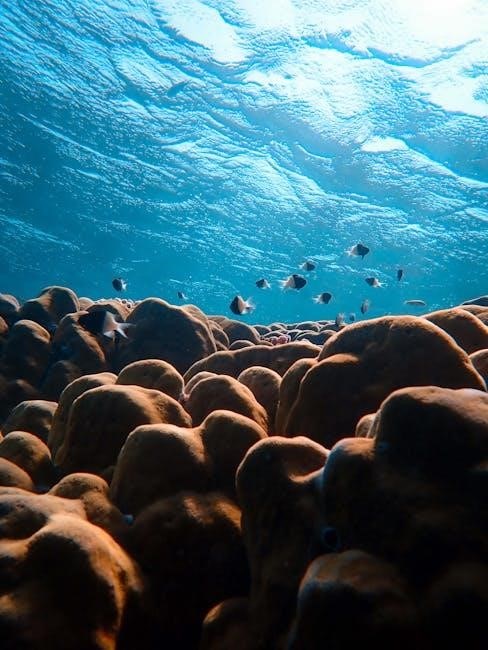
Common Mistakes and Troubleshooting
Common mistakes include overstocking plants, inadequate lighting, and improper CO2 levels. Troubleshoot by adjusting nutrient dosing, pruning dead growth, and ensuring balanced water parameters for optimal health.
Identifying and Solving Common Issues with Aquarium Plants
Aquarium plants can face challenges like melt, pests, or nutrient deficiencies. Common issues include poor growth due to insufficient lighting or CO2 levels. Over-trimming can stress plants, leading to decay. Solutions involve adjusting CO2 injection, improving lighting, and ensuring proper nutrient balance. Regular water changes and monitoring plant health are crucial. For pests, introduce natural predators or treat with safe chemicals. Avoid over-crowding plants to prevent competition. Research specific needs for each species to address root causes. Consistent maintenance and observation are key to resolving issues promptly and promoting a thriving aquarium environment.
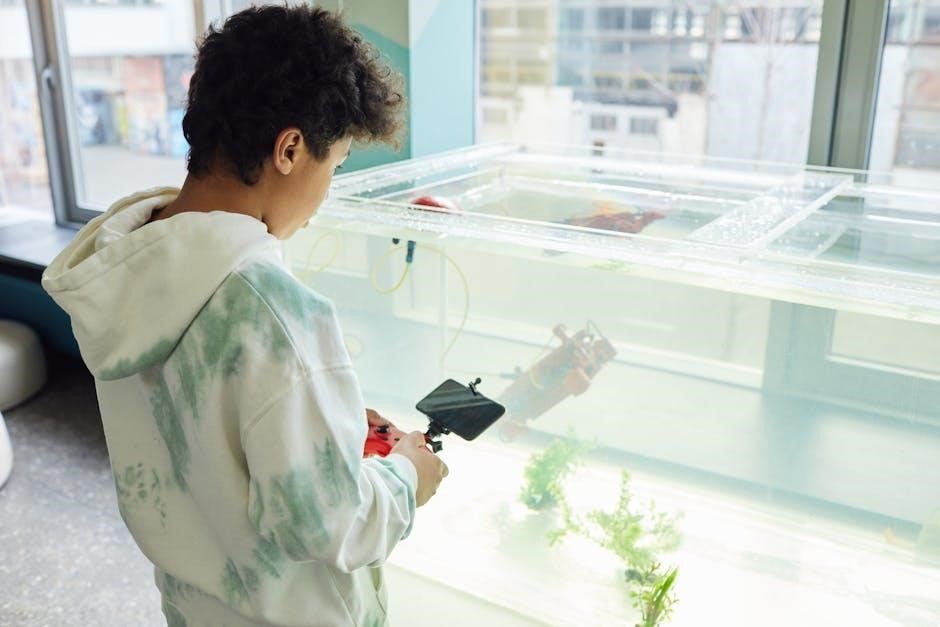
Creating Aesthetic Aquarium Designs
Transform your aquarium into a stunning visual masterpiece. Explore biotope recreations, Iwagumi, and Dutch styles to craft harmonious, balanced designs that elevate aquatic beauty and captivate the eye.
Principles of Aquascaping
Aquascaping is the art of designing visually stunning aquariums by arranging plants, rocks, and other elements harmoniously. Popular styles include Iwagumi, which emphasizes minimalism and balance, and biotope designs that replicate natural habitats. Key principles involve creating depth through layering, using contrasting textures, and maintaining natural proportions. Symmetry and negative space play crucial roles in achieving aesthetic appeal. Choosing plants with varying growth patterns and colors enhances visual interest. Incorporating hardscape elements like driftwood or stones adds structure and focal points. Regular trimming and maintenance ensure plants thrive and maintain the desired design. By blending creativity with technical skill, aquascaping transforms aquariums into breathtaking underwater landscapes.
Creating a thriving aquarium with plants requires understanding their needs and proper care. By balancing aesthetics and functionality, you can build a sustainable, visually stunning underwater world. Happy planting!
Final Tips for a Thriving Planted Aquarium
For a flourishing planted aquarium, consistency is key. Regularly monitor water parameters and adjust CO2 levels as needed. Provide balanced lighting to avoid overgrowth or bleaching. Fertilize sparingly, ensuring nutrient levels align with plant demands. Trim or prune plants to maintain shape and promote healthy growth. Avoid overcrowding to prevent competition for resources. Maintain proper water circulation and filtration to support both plants and fish. Stay observant and address issues early to prevent setbacks. Patience and dedication are essential, as plants often take time to establish. With proper care, your aquarium will become a vibrant, self-sustaining ecosystem, offering beauty and harmony to your space.